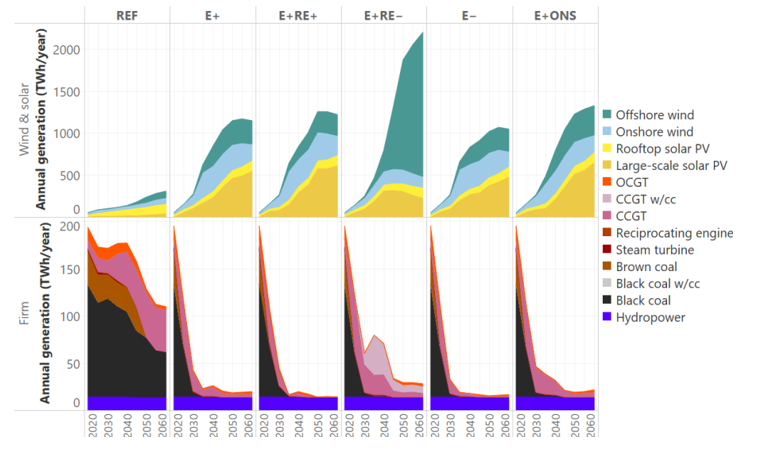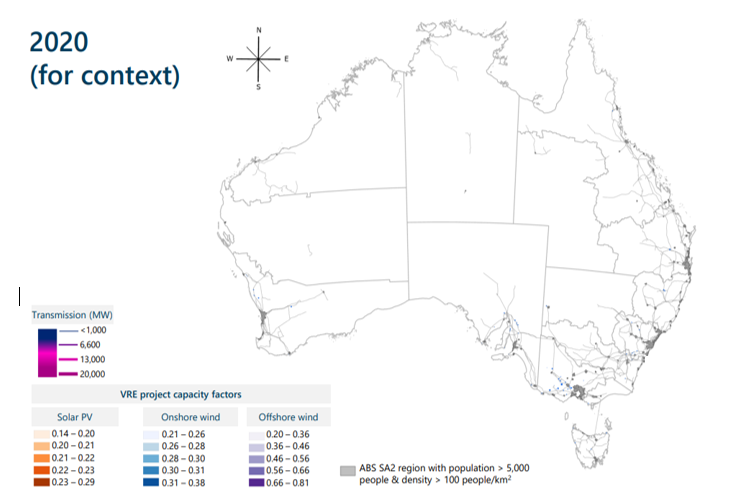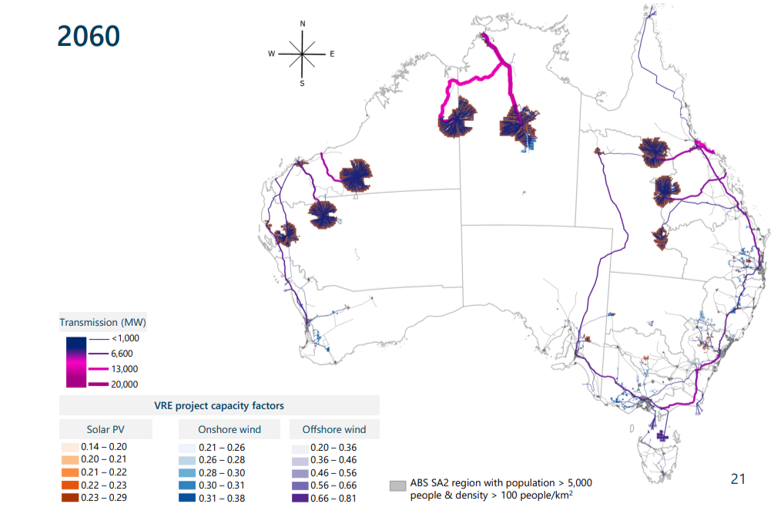What might net zero look like for Australia
A landmark report by Net Zero Australia has modelled what Australia’s pathway to net zero by 2050 might look like. It outlines what we as a nation will need to do to reach net zero, which includes delivering an energy transformation unprecedented in scale and pace; transforming our exports to be an essential contribution to global decarbonisation; and investing in our people and land to reduce impacts and share benefits.
In this Special report, we outline some of the key findings from the report, the steps that will need to be taken to reach net zero, and what this means for investors.
Painting a picture of net zero for everyday Australians
Net Zero Australia, a partnership between the University of Melbourne, University of Queensland, Princeton University, and Nous Group, released its final findings report on 19 April 2023. The report is the culmination of a multi-year study, whose primary objective is to provide rigorous and independent analysis of how Australia might achieve net-zero emissions for the domestic economy by 2050 and export economy by 2060.
Using the same methodology that Princeton University used for the 2020 Net-Zero America study, which ultimately underpinned the Inflation Reduction Act, the independent report models various scenarios of achieving net zero and models the sheer size and scale of what is required to achieve a net-zero future.
“There is no doubt what is required is overwhelming, but the report’s aim was to really paint a picture of what a net zero future looks like on the ground for everyday Australians”, said Professor Michael Brear from the University of Melbourne, one of the key contributors to the report.
The transition is going to require unprecedented collaboration with federal and state government, the private sector, indigenous communities, and everyday Australians.
Professor Robin Batterham, Chair of Net Zero Australia steering committee
The scale, complexity and cost of the net-zero challenge won’t be easy
There will need to be a rapid rollout of renewable energy infrastructure, new transmission lines, storage batteries, electric vehicles, electric charging facilities, heat pumps in homes and businesses and much more. According to Brear, “The results of the report are unprecedented in their detail, rigour and transparency, the aim is to better inform the national debate with solid evidence about the diverse preference of the Australian community and the impacts that each scenario will have”.
The report underlines the scale, complexity, and cost of the net-zero challenge, which it describes as a “once in a generation, globally significant, and nation-building” opportunity. The report explains that the transformation of the domestic economy will enable Australia to be a key player in global decarbonisation, thanks to exports of green energy and critical minerals.
Trillions of dollars will be needed to upgrade, expand, and replace the grid—but also to replace Australia’s lucrative fossil fuel export industries, such as coal, oil and gas, with clean energy substitutes, such as green hydrogen.
“Australia has the opportunity to move from a global laggard in the worlds efforts to deal with climate change, to a global leader.”
Ross Garnaut The Superpower Transformation
Fossil fuel generation to slump, large-scale solar to provide most of Australia’s energy supply
The report modelled straight-line reduction pathways to get to net zero for both domestic emissions by 2050 and fossil fuel export emissions by 2060 (the 2060 commitment reflects commitments by major trading partners) using six different scenarios. The report acknowledges that in every scenario, fossil fuel generation in Australia will fall by 80% by 2030 (Renew Economy (2023), Net zero study report). In almost every scenario, large-scale solar provides the vast majority of Australia’s energy supply by 2050.
“It is imperative that Australia capitalises on the export opportunities presented by decarbonisation, given the demand for our fossil fuels will eventually fall away.”
Key findings of the report

Source: Net Zero Australia—Modelling Summary Report, April 2023.
Which scenarios did the report use?
Business as usual (REF), rapid electrification (E+), slower electrification (E- ), rapid electrification with 100% renewables (E+ RE+), rapid electrification with constraints in build of renewables, (E+ RE-) and rapid electrification with onshoring of processing of raw materials (E+ ONS).
The report’s methodology
It is imperative to note that this study is modelled using various variable inputs (population growth, GDP, energy demand and others) and models straight-line pathways to net zero (which is highly unlikely). It does not consider fossil fuel supply constraints, geo-political threats, or model demand for clean energy exports. So, like all economic models, the results need to be considered in this context.
Given the large, uncertain, and unprecedented changes that are required to achieve net-zero emissions over the next few decades, there will inevitably be different views about the plausibility of each pathway. The report, therefore, uses a transparent methodology, clearly defined and based upon assumptions that are stated objectively and from authoritative sources. It runs six scenarios but does not state which of these pathways is more or less plausible.
Grow renewables as our main domestic energy source
Across all scenarios, wind and solar will dominate primary energy supply in Australia by 2050. According to the study, Australia will need nearly 3 terawatts, or 3,000 gigawatts of wind and solar, if it is to meet its goal of net zero by 2050. To put that into context, Australia currently has around 30 gigawatts of large-scale wind and solar across the country. This really underlines the scale and complexity and cost of the net-zero challenge.
“Australia is well positioned to establish itself as a renewable energy superpower in the global shift away from fossil fuels.”
Alan Finkel Former Chief Scientist
Table 1: Projected domestic electricity generation, by technology to 2060

The role of gas in the transition
Interestingly, the report finds that gas-fired electricity will play a limited but critical role in keeping the electricity system stable during the transition. Whilst wind and solar are backed by batteries and pumped hydro will provide most of Australia’s energy needs at the end of the decade, there will be instances when this will not be enough. In these circumstances, gas-fired plants will provide crucial ‘firming’ services to ensure supply meets demand at peak times. The results show that we need gas capacity but will need to operate it at much less frequency than we do today. Increased capacity does not mean increased generation, what it really does is provide grid stability and reliability during peak winter and summer demand periods. The amount of energy generated from gas falls in the study, but the assets that provide that energy can be called on, at times, to provide a very stable, reliable energy system.
“Australia has the resources to build a new, clean export industry, by producing clean energy carriers, ‘onshoring’ the processing of minerals using clean energy.”
Katherin Domansky Independent member of Net Zero Australia Steering Committee
Greatly increase electrification
To reach net zero, under all scenarios all domestic sectors must fully electrify, with the largest electricity demand growth in transport. Over 2 million public electric vehicle (EV) chargers will be needed to support zero emissions vehicles. Whilst most EV charging will take place at home, a significant number will also be needed at the workplace. Further capacity of Australia’s biggest power system, the national electricity market will have to triple its capacity by 2030 to keep up with the country’s net-zero goals. This means it will need to increase its size 40 times over. Electrification will need to increase to 50% of all energy use, according to the study. This includes EVs and replacing gas-fired heat in homes and businesses.
No role for nuclear unless…
The study finds no role for nuclear-generated electricity—only if the capital cost falls 30% lower than current international best practice, or if renewable build is constrained considerably. It is important to note that the study refers to nuclear technology that we know of and use today, fission technology and large modular reactors. The study does not consider the possibility of a breakthrough in fusion technology, often considered the ‘holy grail’ of clean energy.
Build a clean energy export superpower
The study finds that we will need to grow renewables as our main export energy source, so that by mid-century we have 400–500GW serving our domestic energy system and potentially several thousand GW producing energy exports, compared to just 25GW today. Under each scenario, large-scale solar serves almost all exported electricity.
Attract and invest AUD 7-9 billion of capital by 2060
There is no doubt that all net-zero scenarios modelled by the report will be incredibly capital intensive. The estimated number is around AUD 79 trillion by 2060, with clean energy infrastructure representing 65-75% of total capital requirements.
What does this mean for investors?
The size, scale and significant capital-intensive requirements will present some compelling investment opportunities for investors—but the risks are high, and investors need clarity from policymakers at both the state and federal levels in order to build confidence about the stability of the transition.
At a recent roundtable with key Australian institutional investors on how to encourage more investment into the energy transition, the consensus was that more certainty is needed about the Government’s ‘pathway to net zero’ through regulation or taxonomies if investors are going to be comfortable to scale up their investments—more importantly, to keep up with other jurisdictions to ensure that Australia remains an attractive place to invest. “We don’t want Australia to get left behind because it becomes harder and comparatively less attractive to invest here," said Andrew Fraser, Australian Retirement Trust Chairman. He added “pace is key for us, we have to accept we are operating in a global dynamic, where if others go ahead of us, and set rules in areas where significant capital decisions are made, we will be left on the sidelines” .
Government and policy support will be critical; lack of guidance and mistakes cannot happen. Australians need confidence in stable regulatory outcomes, or we risk choking our energy industry, increasing price volatility and stability, or impacting both domestic and international supply.
Further, careful management of major land use changes will be imperative, including indigenous estate, biodiversity, ecosystems and agriculture. Renewables need much more land area than fossil fuels to produce a given amount of energy. Our renewable resources overlap the lands of First Nations and farming communities, and land with biodiversity value. Careful management will be needed to minimise the adverse impacts, share benefits with affected communities, and achieve a net gain in biodiversity.
“We need to keep pace with other jurisdictions, so Australia remains an attractive place to invest.”
Deanne Stewart Aware Super CEO
Land use impact 2020

Land use impact by 2060

Learn what LGT Crestone can do for your portfolio
With access to an unrivalled network of strategic partners and specialist investment managers, LGT Crestone offers one of the most comprehensive and global product and service offerings in Australian wealth management.
Click 'follow' to be notified when I post next.
2 topics